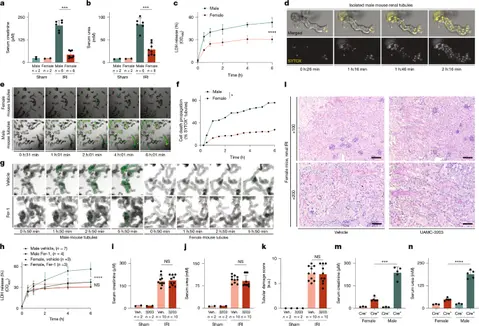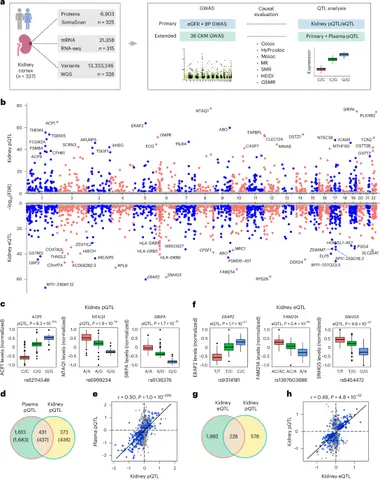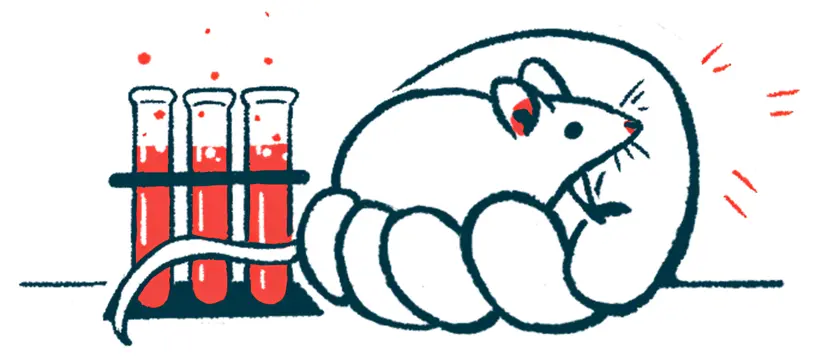T4K3.news
Estrogen protects kidneys from ferroptosis
New study links estrogen pathways to reduced ferroptosis in kidney tubules, offering potential AKI therapies but requiring careful clinical testing.

New findings explain why female kidneys resist acute kidney injury by inhibiting ferroptosis through estrogen both non-genomic and genomic pathways.
Estrogen Protects Kidneys by Blocking Ferroptosis and Reducing AKI Risk
A new study shows 17β-oestradiol helps prevent ferroptosis in kidney tubules, which may explain why females are less prone to acute kidney injury. The researchers identify both non-genomic and genomic actions of estrogen that create an anti-ferroptotic environment. They report that hydroxyoestradiol derivatives act as radical-trapping antioxidants in kidney tubules and can protect male mice from AKI when given exogenously. The study also notes that ESR1 signaling supports anti-ferroptotic pathways, while male kidneys express pro-ferroptotic proteins that estrogen in females seems to suppress before menopause.
The work draws on mouse, porcine and human tissue to strengthen the link between laboratory findings and human biology. It also uses human renal biopsies and public gene-expression data to illustrate how sex and hormonal status might influence susceptibility to ferroptosis and kidney injury. While the results are promising, translating them into therapies will require careful testing to balance potential hormonal effects with kidney protection, particularly in men and postmenopausal women.
Key Takeaways
"17β-oestradiol establishes an anti-ferroptotic state in female kidney tubules."
Main conclusion highlighting the mechanism.
"ESR1 signaling supports anti-ferroptotic pathways while male kidneys show pro-ferroptotic proteins."
Genomic mechanism note.
"If hormones can be harnessed safely, men and postmenopausal women might gain protection from AKI."
Editorial takeaway about clinical relevance.
This study highlights a clear sex difference in kidney injury biology, driven in part by estrogen. It suggests that therapies inspired by estrogen pathways could be tailored to a patient’s sex and hormonal status, rather than applying a one-size-fits-all approach. Yet translating bench findings to bedside will demand rigorous safety reviews, given the systemic effects of hormones. The research also raises questions about how to design trials that account for menopause, age, and comorbidities, while avoiding overstatement of immediate clinical impact.
Highlights
- Estrogen blocks ferroptosis in kidney tubules
- Hormonal paths could guide kidney resilience in injury
- Non-genomic and genomic routes work together to shield female kidneys
- Clinical translation will demand careful trials and clear messaging
Potential translational and hormonal safety risks
The research centers on estrogen pathways to curb ferroptosis, which could affect how kidney injury therapies are developed for men and postmenopausal women. Translating, deploying or recommending hormone-related strategies carries systemic risks and requires cautious, well-designed trials that consider gender, age, and existing health conditions.
Science moves from bench to bedside with care, not haste.
Enjoyed this? Let your friends know!
Related News

Visceral fat linked to faster heart ageing

Kidney Proteomics Maps New Targets for CKM health

Hormone Therapy Reassessed

UTI link to cancer risks under review

Kidney disease drugs expand access to GPs

New study finds estrogen may help MS treatment

Rising cancer rates in young women

Best Foods Women Over 40 Revealed
